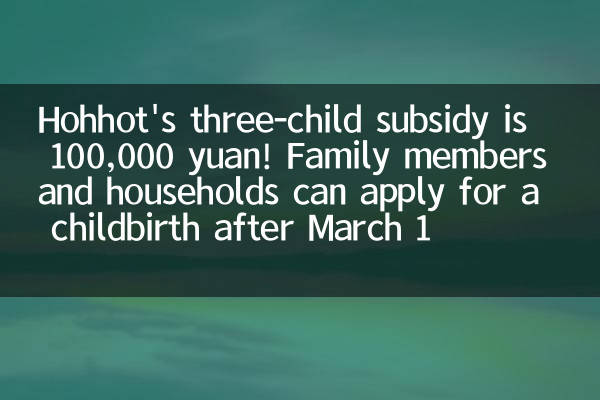Hohhot's three-child subsidy is 100,000 yuan! Family members and households can apply for a childbirth after March 1
Recently, Hohhot City has issued a major policy, giving a subsidy of 100,000 yuan to qualified families for having three children. This policy quickly became the focus of hot discussion across the Internet and attracted widespread attention. The following are detailed interpretations and structured data about the policy.
Policy background

In order to actively respond to the national policy of encouraging the birth of three children, Hohhot City has issued the "Several Measures on Promoting Long-term Balanced Population Development", which clearly proposes to provide birth subsidies to eligible families. The policy aims to alleviate the pressure on family childbirth and promote long-term balanced population development.
Policy content
According to the policy provisions, starting from March 1, 2024, families with household registration in Hohhot and meeting the conditions for "human-housing and households" who have a third child can apply for a subsidy of 100,000 yuan in one lump sum. The following are the specific conditions:
| condition | Specific requirements |
|---|---|
| Household registration requirements | Both or one of the husband and wife has a household registration in Hohhot |
| Housing requirements | Family owns own housing in Hohhot |
| Birth time | The third child born on and after March 1, 2024 |
| Other requirements | Comply with the national birth policy, and the children settled in Hohhot for the first time |
Application process
Eligible families must submit application materials to the street office or township government of the place where their children are registered within 6 months after their children are born. The specific process is as follows:
| step | content |
|---|---|
| 1. Submit an application | Fill in the "Hohhot Three-Child Parenting Subsidy Application Form" and provide relevant supporting documents |
| 2. Material review | The street office or township government conducts preliminary review of the application materials |
| 3. Public announcement | After the initial review is approved, it will be announced for 7 days |
| 4. Issuing subsidies | After the public announcement has no objection, the subsidy funds will be distributed to the applicant's account in one lump sum |
Policy Impact
After the policy was released, it quickly sparked heated discussions in society. The following are the opinions of some netizens:
| Type of opinion | Representative Comments |
|---|---|
| support | "The subsidy of 100,000 yuan is a real help to ordinary families and helps to reduce fertility pressure." |
| question | "Although the subsidy amount is high, the long-term cost of raising a third child is still huge, and the effectiveness of the policy remains to be seen." |
| suggestion | "I hope that supporting measures can keep up, such as increasing childcare services, educational support, etc." |
Expert interpretation
Demography experts said that Hohhot’s three-child subsidy policy is a specific measure taken by local governments to respond to the national birth policy and is of exemplary significance. However, experts also pointed out that fertility subsidies are only part of encouraging fertility, and policies such as childrencare, education, and housing need to be improved to truly alleviate family fertility concerns.
Comparison of related policies
Hohhot is not the first city to introduce a three-child subsidy policy. The following is a comparison of the three-child subsidy policies in some cities:
| City | Subsidy amount | Implementation time |
|---|---|---|
| Hohhot | 100,000 yuan | March 1, 2024 |
| Shenzhen | 19,000 yuan/year (to 3 years old) | September 2023 |
| Changsha | 10,000 yuan | December 2023 |
| Jinan | 60,000 yuan | January 2024 |
Conclusion
Hohhot’s three-child subsidy policy has undoubtedly brought benefits to eligible families, but birth decisions involve many factors, and the effectiveness of the policy still needs time to be tested. In the future, how to further improve supporting measures will become the key to the implementation of policies.

check the details